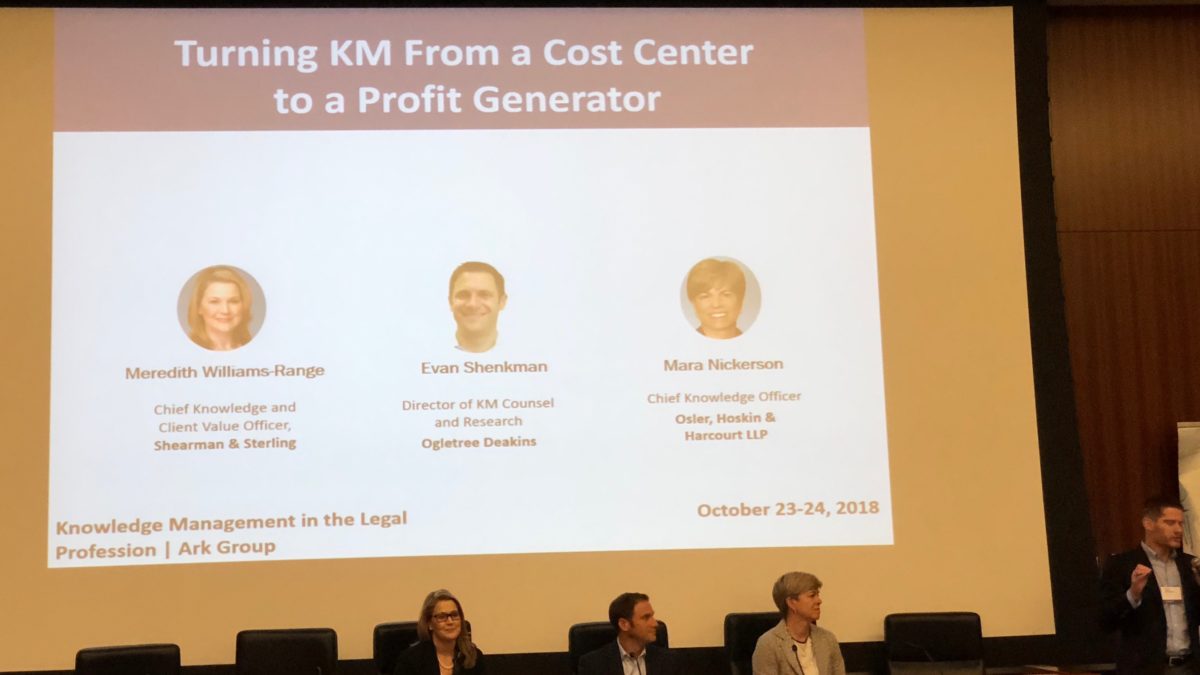Redesigning Law Firm Knowledge Management is a live post from the conference Knowledge Management in the Legal Profession, presented by Ark. I post as a session ends, so please forgive typos or errors in understanding.
The topic is Knowledge Management – From Cost Center to Profit Generator (Live #ArkKM). The panelists:
- Meredith Williams‐Range, Chief Knowledge and Client Value Officer,
Shearman & Sterling LLP - Evan J. Shenkman, Director of Knowledge Management Counsel and Research, Ogletree Deakins
- Mara Nickerson, Chief Knowledge Officer, Osler, Hoskin & Harcourt LLP
The session description appears at the end.
What is KM’ Place in 2018 (Evan). KM started in 2000 and has evolved since. There was a moment in 2012 where some said KM is dead. Evan sites my blog post saying that KM is not dead (thanks for shout-out Even!). Here in 2018
- BTI has found that 74% of client see more innovation from law firms. Evan says KM champions innovation.
- TR found that innovations nets firms more business.
- RFPs in 2017 and 2018 have more questions about service delivery that implicate KM
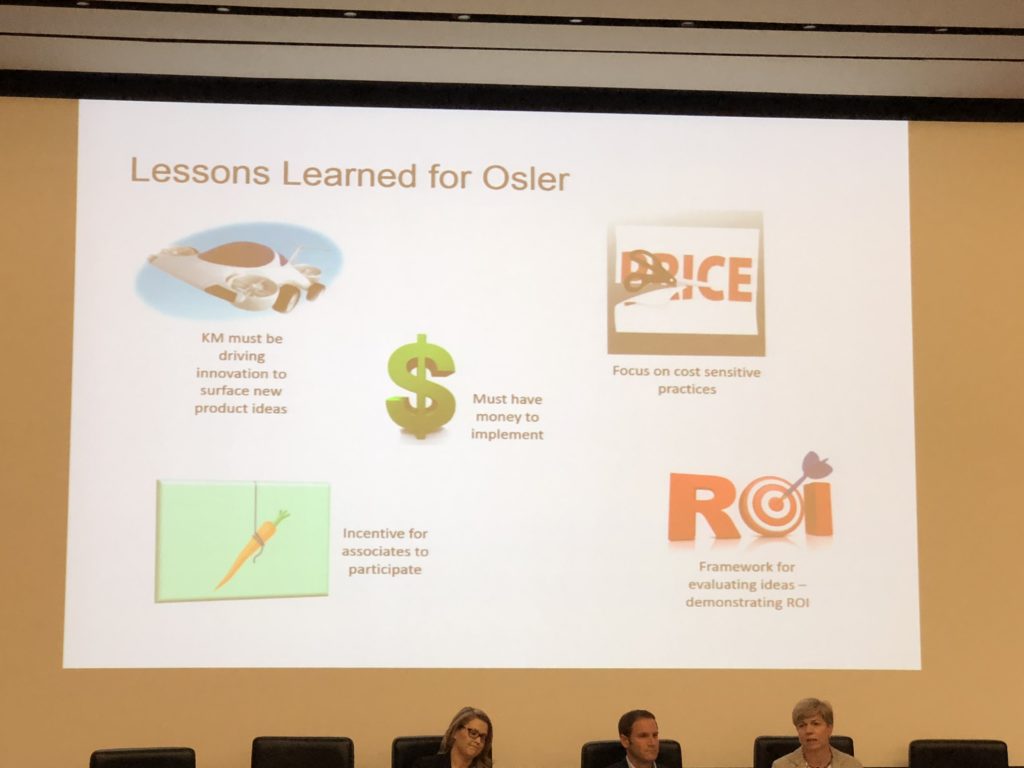
Direct Revenue from KM (Mara). This can be selling subscription services. Mara shows Access Privacy, an Osler online offering. Not huge dollar offering; brings together larges quantities of information around topics. Used by clients and Osler lawyers. Service also offers 30 minute calls to subscribers. Biggest benefit is matter revenue that stems from the subscription service. Lessons learned:
- Focus on fee-sensitive practice areas
- Focus on ROI to justify product. Osler has fund for services but proponents must have biz plan with costs (development and lawyer time) and expected revenue and ROI.
Direct Revenue from KM (Evan). It’s possible to get in the millions of dollars with online subscription products. Ogletree has a new DIY Arbitration tool, OD Comply for wage & hour, background checks, regular labor updates etc.; EEO Advantage for agency charges; and other products. Lessons learned:
- You need a shareholder champion. Services cost money to build – you need someone to go to bat to get the funding.
- Effort must be a collaboration between attorneys and KM team
- You have to spend $ to make $
- Sometimes you have to pull the plug. Not all product development efforts succeed. OD rolled out one tool that did garner enough interest to sustain. Clients preferred more traditional legal advice for this topic. Killed the tool.
- Direct revenue from KM validates KM more generally
- [Mara adds] Voice of the client. Talk to clients if they are interested. Build something that clients want
Shearman: Emerging Company Formation App (Meredith). Will talk about both Baker Donelson (19 years) and her first 6 months at Shearman. At Shearman, on joining 6 months ago, firm had had conversations about direct revenue but had not taken action. Now the firm has. One factor to consider in building a tool is to identify a practice under fee or profitability pressure. At time she joined, firm merged with an emerging company practice. Needed a fast and inexpensive way to start new companies. Use document automation to speed up doc creation. That increased margins about 11%
Another Shearman app involves international stock benefits. Big write offs typically associated with this type of work. Now, when a company wants to offer stock benefits, firm uses a Neota Logic to collect and compile information from local counsel:
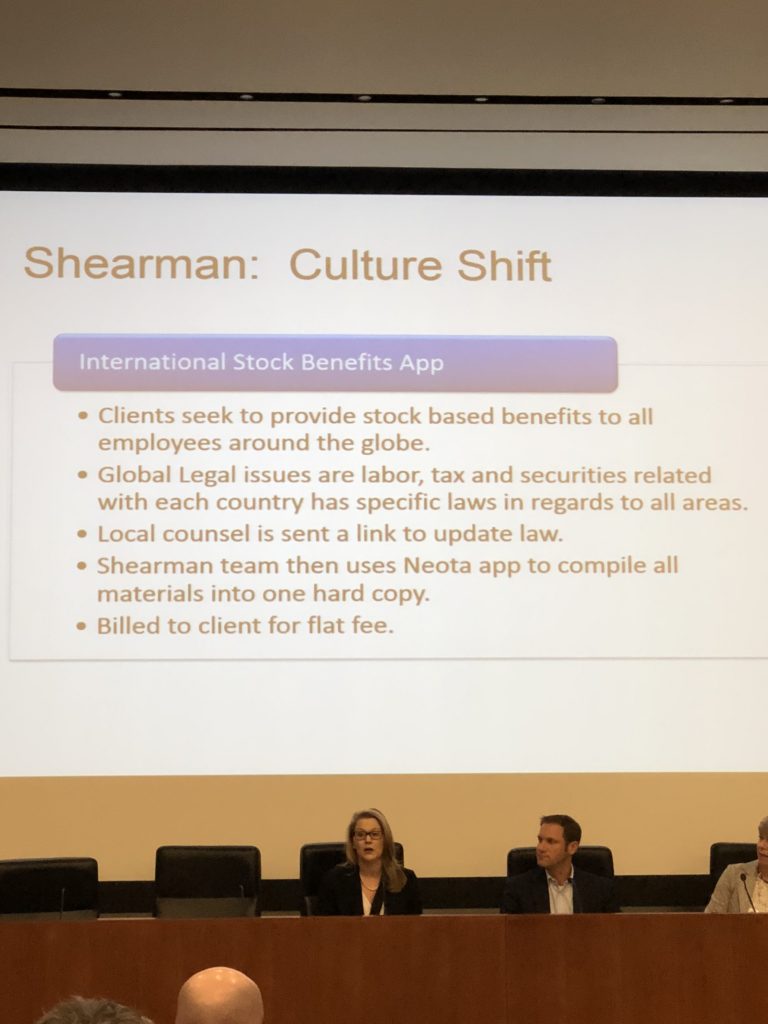
From prior firm (Baker Donelson), Meredith ran a subsidiary that focused on subscription services. The difference in firms illustrates differences in cultures. Firm needs a mindset that not all revenue will be billable hours. At Baker D, lawyers who helped build tools got a portion of the revenue generated. Don’t build without a lot of thought: evaluate market, evaluate building process, have a business plan.
Important to think about and plan for upkeep. Lawyers must commit to updating content. Tech team must keep the tech up to date. Partner with the right tech companies to build services because law firms are not designed to build products
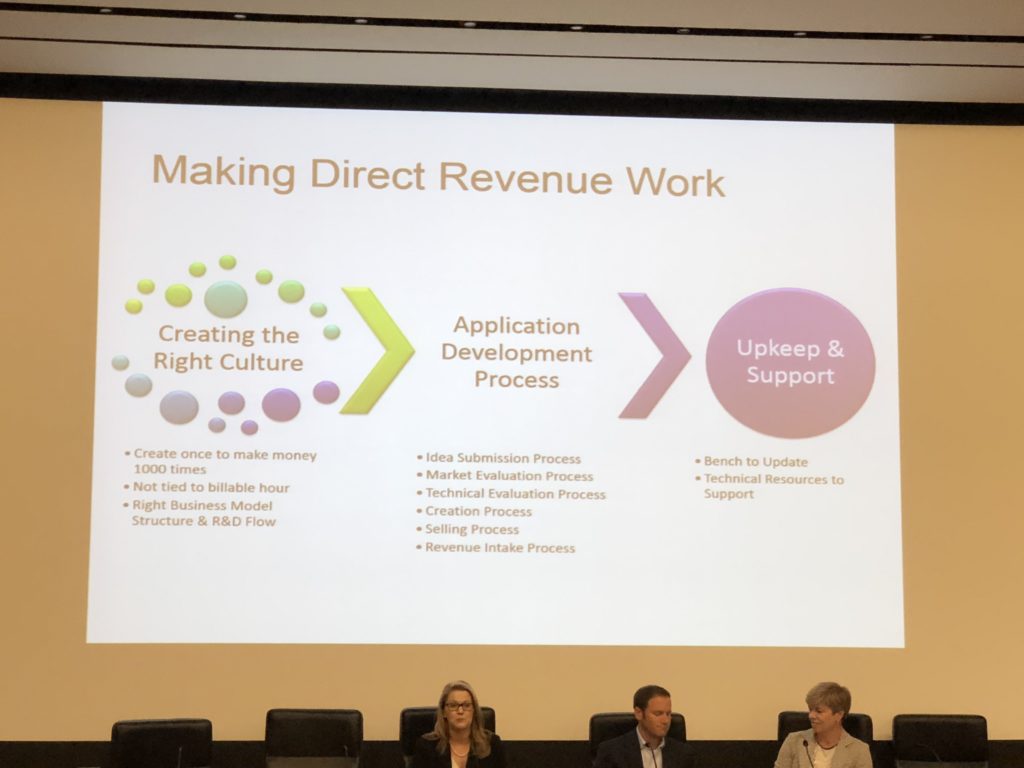
The market evaluation process should be clear:
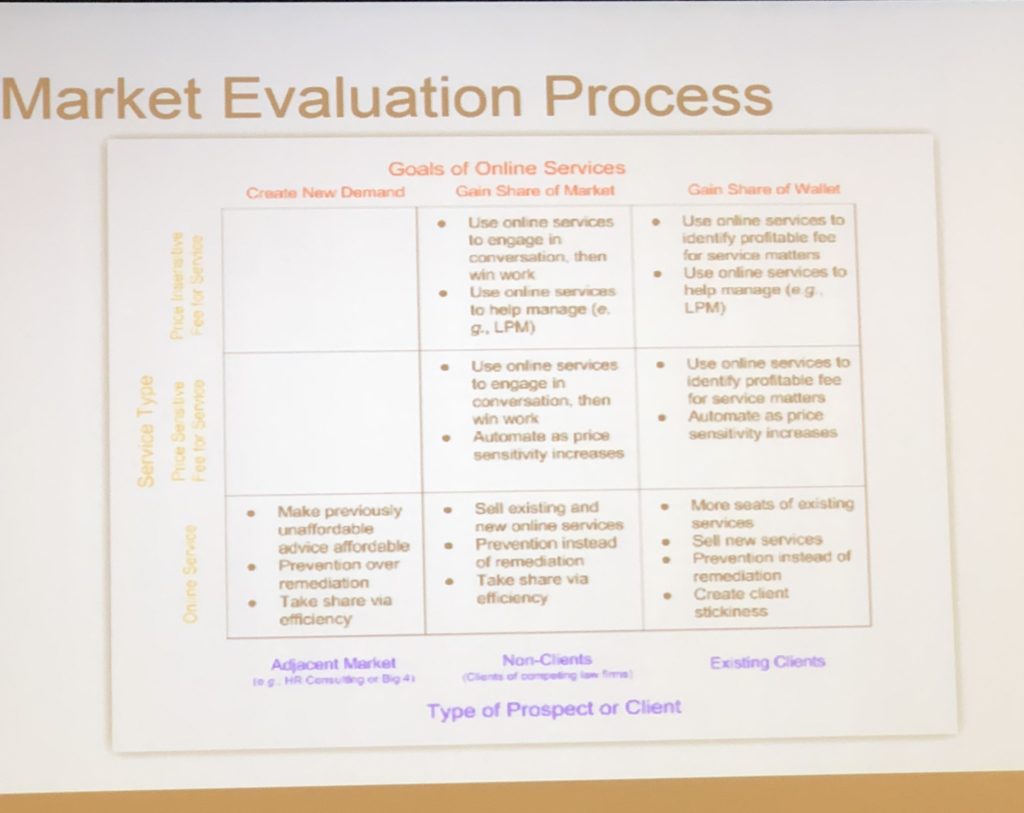
Another issue in developing online services is to understand how to account for subscription fees. Not always obvious in partnership accounting
Indirect Revenue (Meredith). There are benefits to online services beyond direct revenue. Examples include client stickiness and loss leaders. Shearman has some free services that are loss leaders: content-based apps that bring clients to the firm. One example is Merger Matrix. It arouse from water cooler conversation in Brussels office between lawyer and KM. Created an internal Neota app to accelerate merger reviews.
Indirect Revenue (Evan). A variety of online services – internal and external – provide stickiness with clients and internal efficiencies. Lessons learned include: collaborate closely, clients are interested in what’s behind the curtain, attorneys are more willing to share than in the past, competitive advantage because tools are free.
Indirect Revenue (Mara). Free for clients. Idea from an associate. “Osler Code Detect” analyzes open source software that looks at code to ensure there are no risks with licenses / fees with its underlying libraries / code sets used. This has generated work for that associate. Firm also offers free client process mapping sessions. It always generates legal work. Moral of process mapping is that not all indirect revenue flows from tech.
Shifting Business Model. Panelists says that above illustrates how the business model is shifting away from pure billable hour work. One example, real estate at Osler has mapped its practices, integrated with contract express > this has streamlined their service and they sell on that basis. Shearman has done internal practice-focused process improvement opportunities. That led to internal applications that improve lawyer efficiency and reduce write-offs.
As a capstone for this session, I love a slide that Evan shared – the growing role of KM in firm pitches:
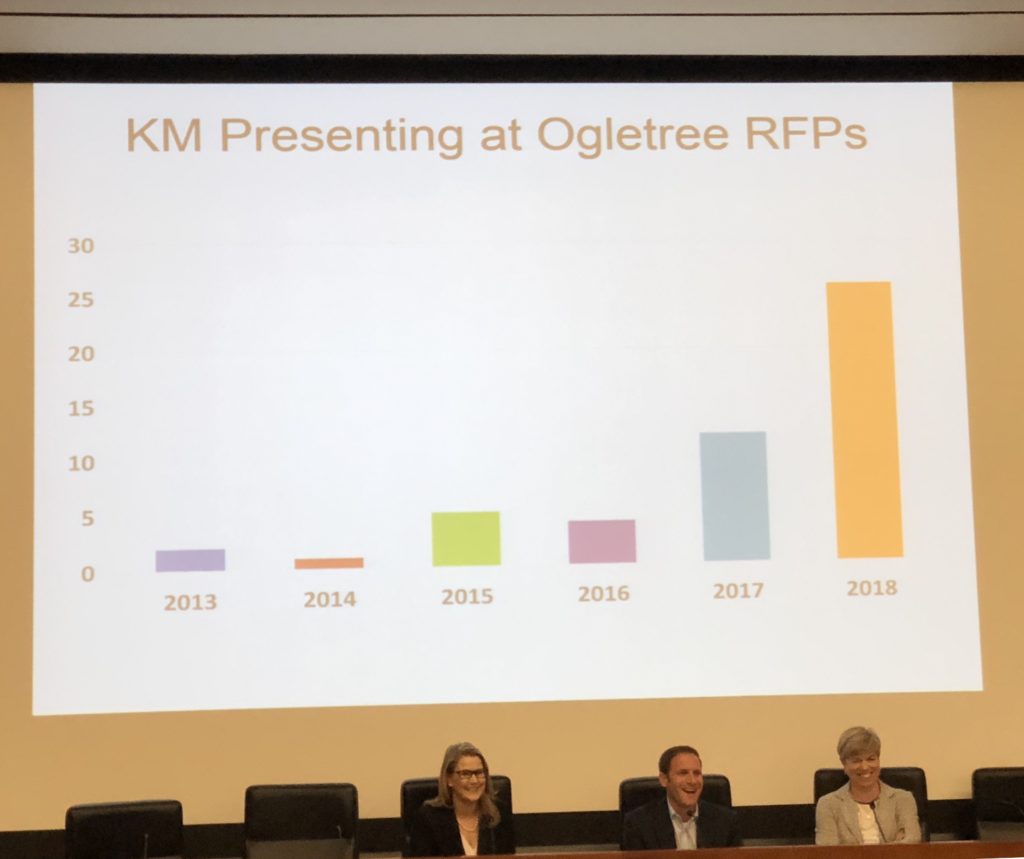
Knowledge Management—From Cost Center to Profit Generator
Using KM to Bring Business into Your Firm
Many firms shortsightedly think of KM as a cost center, rather than a revenue generator. This discussion will illustrate different ways that firms have successfully turned the script by using KM to bring in meaningful firm business—both at the pitch stage, and as a revenue‐generator with KM client‐facing service offerings. Learn how these successes increase KM buy‐in internally, help justify KM headcount, and illustrate that KM is a differentiator between firms that have it ‐ versus firms that do not.
Archives
Blog Categories
- Alternative Legal Provider (44)
- Artificial Intelligence (AI) (57)
- Bar Regulation (13)
- Best Practices (39)
- Big Data and Data Science (14)
- Blockchain (10)
- Bloomberg Biz of Law Summit – Live (6)
- Business Intelligence (21)
- Contract Management (21)
- Cool Legal Conferences (13)
- COVID-19 (11)
- Design (5)
- Do Less Law (40)
- eDiscovery and Litigation Support (165)
- Experience Management (12)
- Extranets (11)
- General (194)
- Innovation and Change Management (188)
- Interesting Technology (105)
- Knowledge Management (229)
- Law Department Management (20)
- Law Departments / Client Service (120)
- Law Factory v. Bet the Farm (30)
- Law Firm Service Delivery (128)
- Law Firm Staffing (27)
- Law Libraries (6)
- Legal market survey featured (6)
- Legal Process Improvement (27)
- Legal Project Management (26)
- Legal Secretaries – Their Future (17)
- Legal Tech Start-Ups (18)
- Litigation Finance (5)
- Low Cost Law Firm Centers (22)
- Management and Technology (179)
- Notices re this Blog (10)
- Online Legal Services (64)
- Outsourcing (141)
- Personal Productivity (40)
- Roundup (58)
- Structure of Legal Business (2)
- Supplier News (13)
- Visual Intelligence (14)

